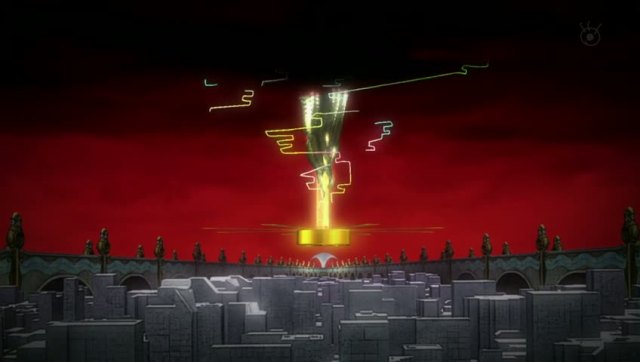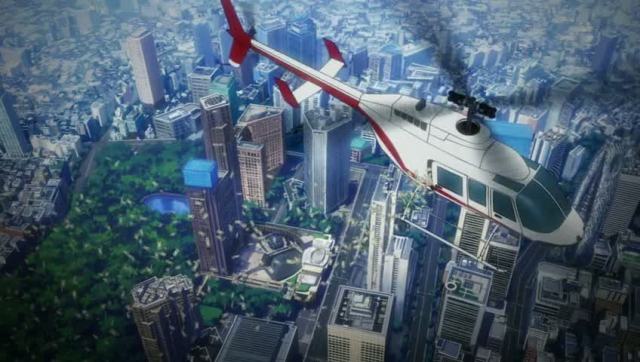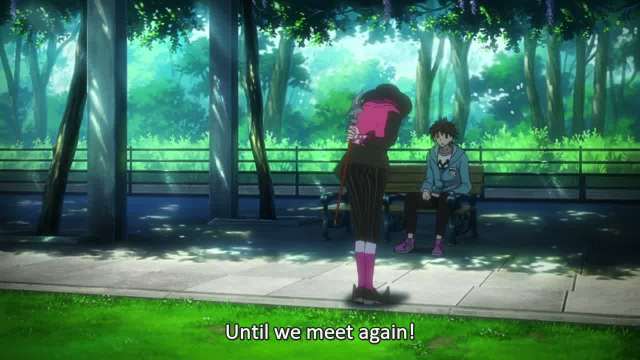“If all that’s left is a future with no possibility, there’s no reason for the present to exist.” – Sennoza Kou, [C] Episode 6
“It’s not about sacrificing the present in order to save the future, it’s about restoring the future that was meant to be there from the start.” – Kimimaro, [C] Monologues
What’s all this talk about “saving the present or the future ?”, and does it mean anything in real life ? It does, and it is the biggest economic issue of this decade. Because our politicians hopelessly try to maintain an unsustainable present with economic wizardry, we might be headed towards a future far bleaker than the Great Depression of 1929.
In fact, even with all their shenanigans, today is far from great – millions of people have lost their jobs, ruined their credit, filed for bankruptcy, lost their homes and lifestyle. Unemployment is higher than expected. Prices are rising faster than ever. Who knows how bad it’s going to be when the smoke clears out and the illusory wealth from the stimulus fades away ?
To understand what got us in this mess and what will make it even worse, we need to wind the clocks back 15 years.
__________________________________________________________________
DISCLAIMER : This article is, of course, not exhaustive and is meant as an introduction.
THE FOLLOWING PART ABOUT BUBBLES IS FAIRLY LENGTHY, SO IF YOU WANT TO SKIP IT, THE TLDR IS : THE FEDERAL RESERVE’S DISTORSION OF THE ECONOMY FUELED THE DOTCOM BUBBLE, THEN WHEN IT POPPED THEY CREATED THE HOUSING BUBBLE TO REPLACE IT (BUT IT LEFT THE ECONOMY EVEN WORSE OFF THAN BEFORE), AND NOW THEY’RE CREATING SOME SORT OF GENERAL BUBBLE (WHICH WILL OBVIOUSLY RESULT IN UNFORTUNATE CONSEQUENCES).
The Internet Bubble (1995-2001)
1995.There is massive euphoria for technology startups. Small companies with little to no intrinsic value get massive valuations on the stock market.
“People were getting rich, but none of the people were getting rich because the businesses were successful. The people were getting rich because suckers were buying their stock.” –Peter Schiff, president of Euro Pacific Capital
The Federal Reserve (central bank of the United States) sees this and attempts to fuel the mania even more. It forces low interest rates by essentially printing money (taking wealth from everyone who owns dollars), encouraging more and more speculation and causing prices to rise through the roof. The NASDAQ goes up over 80% from 1998 to 1999. Companies were going public with little more than a domain name and a cool concept. Some people quit their jobs to become daytraders because stocks just couldn’t keep themselves from rising.

Of course, you know where this was headed. You can’t create economic growth out of thin air; if you try to, then you will have to pay it back later – with interest.
In 2000, the Federal Reserve, worried about an overheated economy, raised back its rates massively, causing the artificial credit to vanish and the whole dotcom masquerade to crumble under its own weight. This was actually a good move from the Federal Reserve, and prevented an even bigger crash.
Investors got wiped out left and right, unemployment went up, and the Fed/government blamed Wall Street for its “irrational exuberance”. Sounds familiar to what happened a few years later ? It is.
Housing Bubble (2001-2008)
“To fight this recession the Fed needs more than a snapback; it needs soaring household spending to offset moribund business investment. And to do that, Alan Greenspan needs to create a housing bubble to replace the Nasdaq bubble.”
These were the words of Paul Krugman, an economist who would later be awarded a Nobel Prize – but you can probably see by this quote alone how his Nobel Prize in Economics is worth as much as Obama’s Nobel Peace Prize.
The economy was meant to go into a recession following the dotcom crash, in order to purge out all the malinvestments that were made in the fake economy.
Except if there was some sort of stimulus!
The Federal Reserve didn’t disappoint and did exactly as Krugman said ; it forced low interest rates again. It created Fannie Mae and Freddie Mac, two government institutions who would co-sign mortgages – if the lender couldn’t pay back, then the government would pay back. They created all sorts of incentives to inflate the housing market, wrapped in the “Home ownership for everyone ” propaganda.
And a bubble started again, except it was not just investors now – it was everyone.
People bought houses they couldn’t afford because they were convinced that they would get rich from prices rising. The average home buyer believed his house would appreciate 20% a year. People quit their jobs to build or flip houses. And for a few years everyone made money.
Mortgage brokers got their commissions, homeowners got their home appreciation, banks could sell mortgages to investors who would reap the benefits, and everyone was happy.

[“I said, “Okay, but, what if the house price goes down?” And he looked at me like I was from Mars.] – Peter Schiff
Eventually everyone had a home, but some of the people couldn’t pay their mortgages and defaulted. So :
1) housing prices fell, and
2) the remaining people had to pay more in loans than their house was worth. So
3) they also defaulted. And since everyone already had a home, no one was going to buy foreclosures, which brings us back to step 1.
And the housing bubble collapsed, just like the dotcom bubble. It left the economy even worse off than in 2001, and home/stock prices went in free fall – headed back towards their real value.
“Almost overnight, the talking heads went from perpetuating the euphoria of investors to rushing to pronounce the economy dead. ” Mint.com
The “bailout” bubble (2008-201[]?)
Financial companies and carmakers (who were affected by the downturn because Americans couldn’t afford cars anymore) came to the government asking for a bailout , and unsurprisingly, they got it. Meanwhile the geniuses at the Fed thought another stimulus would get the economy back up in shape. So they forced low interest rates (sounds familiar ?) and borrowed+printed trillions.
It didn’t work as well as they expected, so they’re printing even more.
The economy looks like it has recovered a bit, but by now you should know what will inevitably happen.
_________________________________________________________________
Saving the Present or Bringing the Future Back ?
“Currently, you hear people saying the economy is doing well… but you saw how it really was just a while ago. The large sums of money being injected into this country are destroying the country’s balance.”
“If all that’s left is a future with no possibility, there’s no reason for the present to exist.”– Sennoza Kou, [C] Episode 6
“In the US, we have a totally new school of economics, and it’s called the Zimbabwe school. It’s founded by one of the great leaders of this world – Mr Robert Mugabe – who has managed to totally impoverish his own country. That is the monetary policy the US is pursuing – if something goes wrong, print. If it doesn’t get fixed, print more. If it becomes even worse, print even more.” – Marc Faber, investment advisor and fund manager
The two crashes of 2000 and 2008 should tell us that trying to manipulate the economy in an attempt to improve the present is unsustainable and will lead to unfortunate consequences in the future. Unfortunately, politicians have no incentive to return the economy to a clean state (“restoring the future that was meant to be there from the start”), as this means having a recession to counterbalance the excess of the previous years.
“The world is already taking Midas Money from granted. It will collapse if we stop the flow. A lot of people would meet misfortune.” – Mikuni Soichiro, [C] Episode 5
They would rather play hot potato, and hope to delay the inevitable by turning on the printing presses and maintaining a fake economy. But the show cannot go on forever. Every subsequent crisis will be worse than the one before it. More “Midas Money” stimulus will be required to delay its effects, resulting in even bigger crashes – and eventually we’re going to get blown up for good !
Killing the Yen and switching to the Dollar
“I knew it was all a confidence game, but I never expected people could lose trust in the Financial District so quickly !” – Takedazaki, [C] Episode 11
Some people have joked that Ben Bernanke, chairman of the Federal Reserve, might be against fiat currency, and that he is printing money in order to deliberately cause hyperinflation and destroy the dollar forever, moving to a sound currency that could not be manipulated by central banks.
Zimbabwe has actually gone through the same events as Japan in [C]; following the total devaluation of their currency, people now trade goods in foreign currency – mainly US Dollars.
What happened after they abandoned their currency ?
In February 2009 Zimbabwe was the only country in the world without debt. Nobody owed anyone anything. Following the abandonment of the Zimbabwe Dollar as the local currency all local debt was wiped out and the country started with a clean slate.
It is now a country without a functioning Central Bank and without a local currency that can be produced at will at the behest of politicians.
Price controls and foreign exchange regulations have been abandoned. Zimbabwe literally joined the real world at the stroke of a pen. Money now flows in and out of the country without restriction. Super market shelves, bare in January, are now bursting with products.
There has been a sharp rise in economic activity since February. Real wages have risen substantially compared to a year ago. Whatever workers were paid in Zimbabwe Dollars during the hyperinflation bought virtually nothing. Now even the minimum wage of around $100 per month allows for basic purchases. A 10kg bag of maize meal, a staple in the local diet, costs $3.50 and lasts for two weeks. Demand for products and services is increasing rapidly. Corporate profits are rising, leading to greater tax revenues for the Government, augmented by rising VAT taxes. Greater Government revenue allows for greater Government spending.
This self-reinforcing loop will continue. The improvement in the economy will become dramatic once Mugabe leaves the scene. At that time aid agencies, NGO’s, Charities and foreign governments will start injecting large volumes of funds and assistance into the country.
With Mugabe out of the way and the economy recovering strongly, one could reasonably anticipate that a large proportion of the Zimbabweans living overseas will return to the country bringing welcome skills and capital. Indeed foreigners will also be attracted to investing in the country in those circumstances.
It is fascinating to see how rapidly the economy is recovering. It is a great testament to what can be achieved in a free enterprise environment by the elimination of controls combined with the institution of new money that people trust. It needs to be money that their Government cannot create via the printing (or electronic) press.
The economic future of Zimbabwe is likely to be in mining, agriculture, tourism and service industries, especially those providing infrastructure and maintenance facilities. There remain many problems, not the least being chronic unemployment, but the future looks bright beyond the Mugabe horizon. The population is amongst the best educated in Africa and most people can speak English. With the Zimbabwe’s natural assets, there is scope for realistic optimism about the economic future, especially once the current political difficulties are overcome.
-http://www.kitco.com/ind/Field/nov112009.html
But the Central Bank Chief, Dr Gono, knows that this recovery may be short-lived until they switch to a sound currency, as Helicopter Ben’s monetary policy is starting to look more and more like Mugabe’s.
“There is a need for us to begin thinking seriously and urgently about introducing a Gold-backed Zimbabwe currency which will not only stable but internationally acceptable,” he said in an interview with state media. “The world needs to and will most certainly move to a gold standard and Zimbabwe must lead the way.” Gono said the inflationary effects of United States’ deficit financing of its budget was likely to impact other countries to leading to a resistance of the green back as a base currency.
-http://www.newzimbabwe.com/business-5127-RBZ+urges+gold-backed+Zim+dollar/business.aspx
__________________________________________________________________
Kenji Nakamura said he wanted this show to get people interested in economics. I hope this post has helped a bit.
If you enjoyed reading this, please leave a short comment – I’m a shallow person and I like to know my work helped someone.
Feedback and questions are also appreciated !





